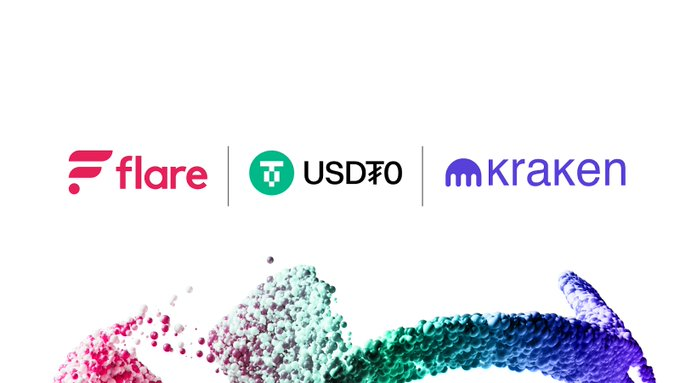Flare Network’s TVL Surge: The Technology Behind the Data
In May 2025, Flare Network (FLR) experienced a dramatic increase in total value locked (TVL), jumping from $45 million to $120 million in just two weeks—becoming a major topic across the blockchain industry. This surge was driven by the innovative integration of its cross-chain stablecoin USDT0 and its synergistic ecosystem incentive plan. As a Layer 1 blockchain focused on data interoperability, Flare is redefining multi-chain DeFi competition through cross-chain technologies and high-yield liquidity mining.

Flare’s core technical strength lies in its Hydra cross-chain protocol, which allows users to seamlessly transfer USDT0—a cross-chain stablecoin pegged 1:1 to the U.S. dollar—across 75 blockchain networks including Ethereum and Solana. In April 2025, Flare launched USDT0 in partnership with Tether and simultaneously initiated the USDT0 Boost program, allowing users to stake USDT0 or FLR tokens and earn rFLR rewards with up to 30% APY. This strategy immediately drove market demand—the number of daily active addresses on Flare exceeded 85,000 in the first week, while on-chain transaction volume surged 340%.
USDT0: The Key to Cross-Chain Liquidity Integration
The launch of USDT0 marked Flare’s strategic transformation from a “data oracle network” to a cross-chain liquidity hub. Its technical architecture is based on LayerZero V2, allowing users to mint and burn USDT0 on any chain, with Flare’s Time Series Oracle (FTSO) providing real-time cross-chain price verification. This setup resolves the liquidity fragmentation problem common in traditional cross-chain bridges. For example:
-
Low slippage swaps: On SparkDex (Flare’s top DEX), users can swap USDT0 for BTC or ETH with only 0.1% slippage—far more efficient than mainstream bridges.
-
Instant settlement: Flare’s modified Avalanche consensus reduces transaction confirmation time to just 1.8 seconds, comparable to high-performance chains like Solana.
Incentive-wise, the USDT0 Boost program uses a dual-reward model to attract capital:
-
Base yield: Users staking USDT0 receive a fixed 12% APY.
-
Bonus yield: Staking FLR tokens in addition raises the APY to a maximum of 30%.
This mechanism not only caused TVL to skyrocket but also pushed the FLR token price up 7.2% on May 5, reaching a two-year high.
Users can purchase FLR tokens and participate in Flare’s liquidity incentives via JuCoin’s multi-chain trading platform.
Ecosystem Expansion: From Oracle to DeFi Infrastructure
Flare’s ambitions extend far beyond stablecoins. Back in 2024, it launched the FAssets system, enabling non-smart-contract chain assets (like XRP and DOGE) to access DeFi. In February 2025, Flare upgraded FAssets to support cross-chain BTC staking as FBTC, which can be used as collateral on the Kinetic lending protocol. Kinetic’s TVL has since surged from $15 million to $60 million, becoming a major driver of Flare’s growth.
Another key use case is gamified on-chain applications. In March 2025, Flare launched the “Flare Fair” virtual expo, where users completed tasks like cross-chain transfers and liquidity staking to earn NFT blind boxes—attracting over 120,000 users. This “DeFi + Entertainment” model lowered the barrier for new users. According to Dune Analytics, unique addresses on Flare rose 58% during the campaign.
Risk Warning: Can High Yields Last?
Despite its rapid growth, Flare faces several challenges:
-
Incentive dependency: The current 30% APY mostly comes from rFLR token emissions from the protocol’s reserves. If rewards shrink, capital may exit.
-
Regulatory uncertainty: The U.S. SEC has placed FLR on a “watchlist of unregistered securities,” which may hinder its U.S. expansion.
-
Competitive pressure: Chains like Cosmos are rolling out similar cross-chain liquidity solutions, pulling developers and users away.
Future Outlook: Long-Term Value of Cross-Chain Data Services
Flare’s next focus is strengthening its position as a data infrastructure provider. In Q3 2025, it will launch the full version of FAssets, supporting cross-chain staking of XRP and DOGE and integrating Trusted Execution Environments (TEE) for enhanced privacy. Over the long term, Flare’s FTSO V2 aims to boost data refresh rates to once per second, enabling real-time support for AI-driven on-chain trading strategies.
For retail investors, the simplest way to participate in the Flare ecosystem is to purchase FLR or stake USDT0 for stable yields. As demand for cross-chain interoperability grows, Flare may become an indispensable data and liquidity layer in the Web3 world.





